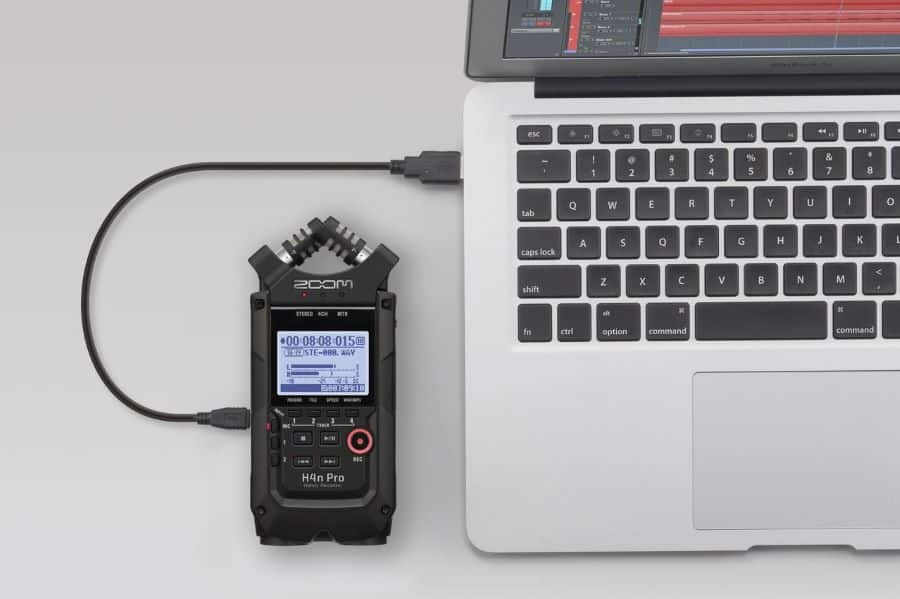The H4N is a helpful handheld recorder manufactured by Zoom Corporation. It offers a built-in stereo XY microphone, an input jack for an external mic, and a full display with backlighting to manage your recordings.
Its command structure is straightforward, offering a few shortcut buttons to help you find folders and files. You can even control your speed and the file type used to create content with this device.
When you need to give your Zoom H4N more power, here are the steps to take to have a successful result.
Please note that the Zoom H4N Is different from the Zoom H4N Pro.
How Is Power Supplied to the Zoom H4N?
When you use the Zoom H4N for your recording needs as a podcaster, two power options are available for the unit.
You can supply it with two AA batteries or have the AD-14 power adaptor that’s sold separately. When you connect the device to a wall receptacle, you can use it even if the batteries have died.
The AC adapter plugs into the bottom of the unit. Using one other than the Zoom AD-14 could cause delivery problems that may cause the recorder to malfunction.
If you want to charge the Zoom H4N, you’ll need to purchase rechargeable batteries and a separate charger for them to have the best recording experience.
Before unplugging the unit or removing the batteries, ensure the H4N is powered off. If it is on and loses power, the quality or integrity of the stored recording could be jeopardized.
Battery and Power Options for the Zoom H4N
When using the H4N with batteries, you have two settings on the unit to operate. The recorder can be set up for everyday use or switched to “stamina mode.”
If you use the typical AA alkaline batteries to power the H4N, you’ll receive about six hours of use in its standard setup. In stamina mode, you get about 11 hours. Those figures are based on recording at 16-bit format and WEAV 44.1 kHz.
When the battery starts to run low, you’ll see an indication appear on the screen. That’s when you’ll want to switch the power off, exchange batteries, or start using the AC adapter.
The Zoom H4N accepts conventional alkaline or nickel metal hydride batteries. If you have the latter option, you can recharge them for continued use, but not while they’re still in the recorder.
Related: 5 Best Podcast Recorders For Capturing High-Quality Audio
How to Recharge NiMH Batteries

Zoom H4N connected to mac via USB. Image source.
Most nickel metal hydride batteries come with a proprietary charger you’ll need to restore the power they can provide. They’re typically used with an AC adapter that plugs into a standard household receptacle.
Some brands offer a rapid-charge design that quickly restores power, but it can also significantly reduce the overall lifespan of the batteries.
It helps to run the rechargeable batteries down all the way the first time they’re used. This action decreases the risk of a memory effect that reduces the recharging capacity after each use.
After plugging the charger into the outlet, you’ll need to insert each battery into the correct configuration. The positive and negative ends should be marked on the unit, which you can match up to the battery.
The rechargeable batteries must remain with the charger until they are ready for use again. You should see a light change color to indicate this fact. If the process gets interrupted for any reason, the battery life rating can be significantly diminished.
Once the charging process is complete, you can take the batteries from the charger and put them back into the H4N.
Can I Connect the Zoom H4N to Get USB Power?
The Zoom H4N does offer a USB connection to a computer. You can use the bus power supply when operating the recorder as an audio interface or SD card reader.
It helps to connect the H4N to the USB after the other end of the cable is already connected to your computer. The power switch should be off to prevent recording corruption.
Once you connect the USB, the power will automatically turn on from the supply. This action will not charge your nickel metal hydride batteries.
The best way to ensure your battery life is conserved is to turn off the H4N after you’ve finished recording.
When you have a portable recorder available to use, it becomes much easier to include interviews and other content in your podcast. If you can manage this need by using rechargeable batteries with the Zoom H4N, your costs will stay low without limiting the portability of your setup.
Related: How To Use Zoom H4N with iPhone for Recording Professional-Quality Audio